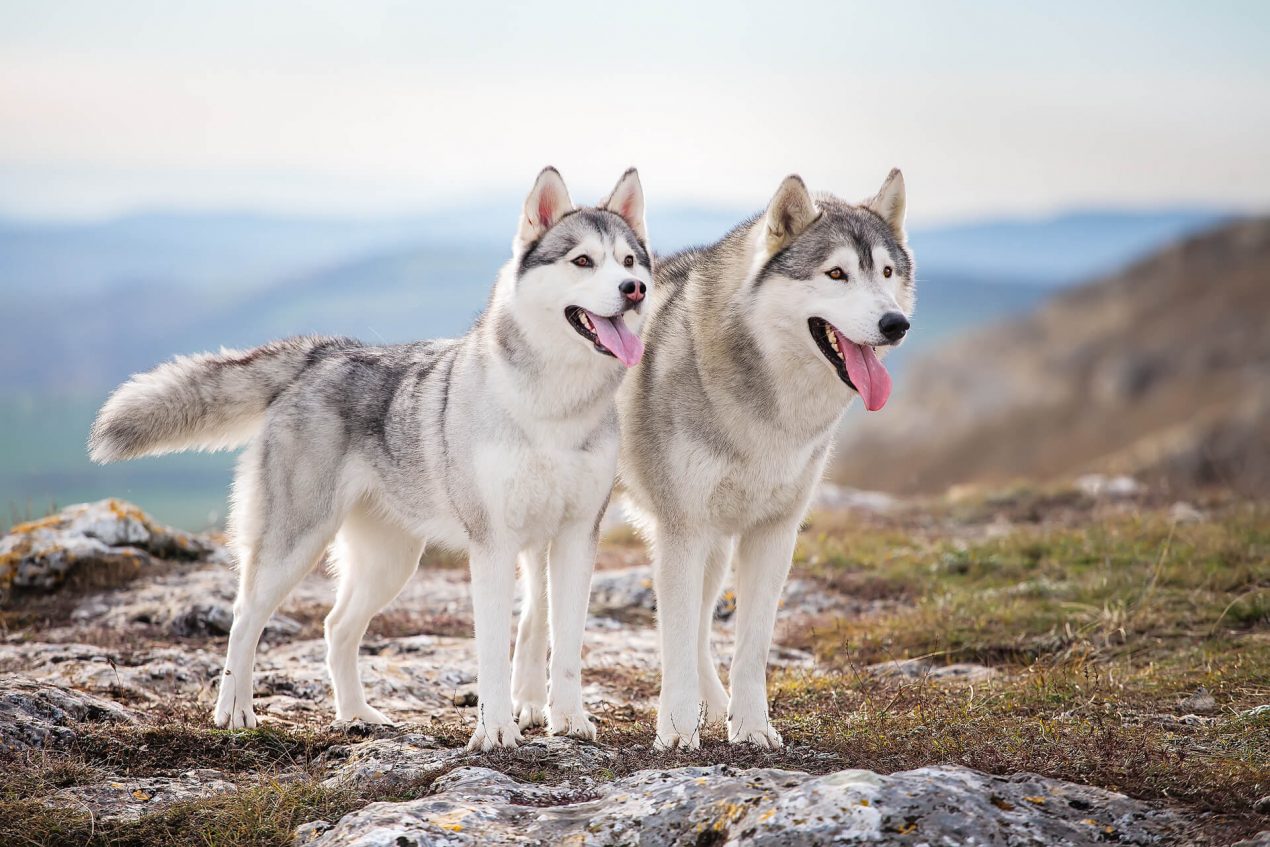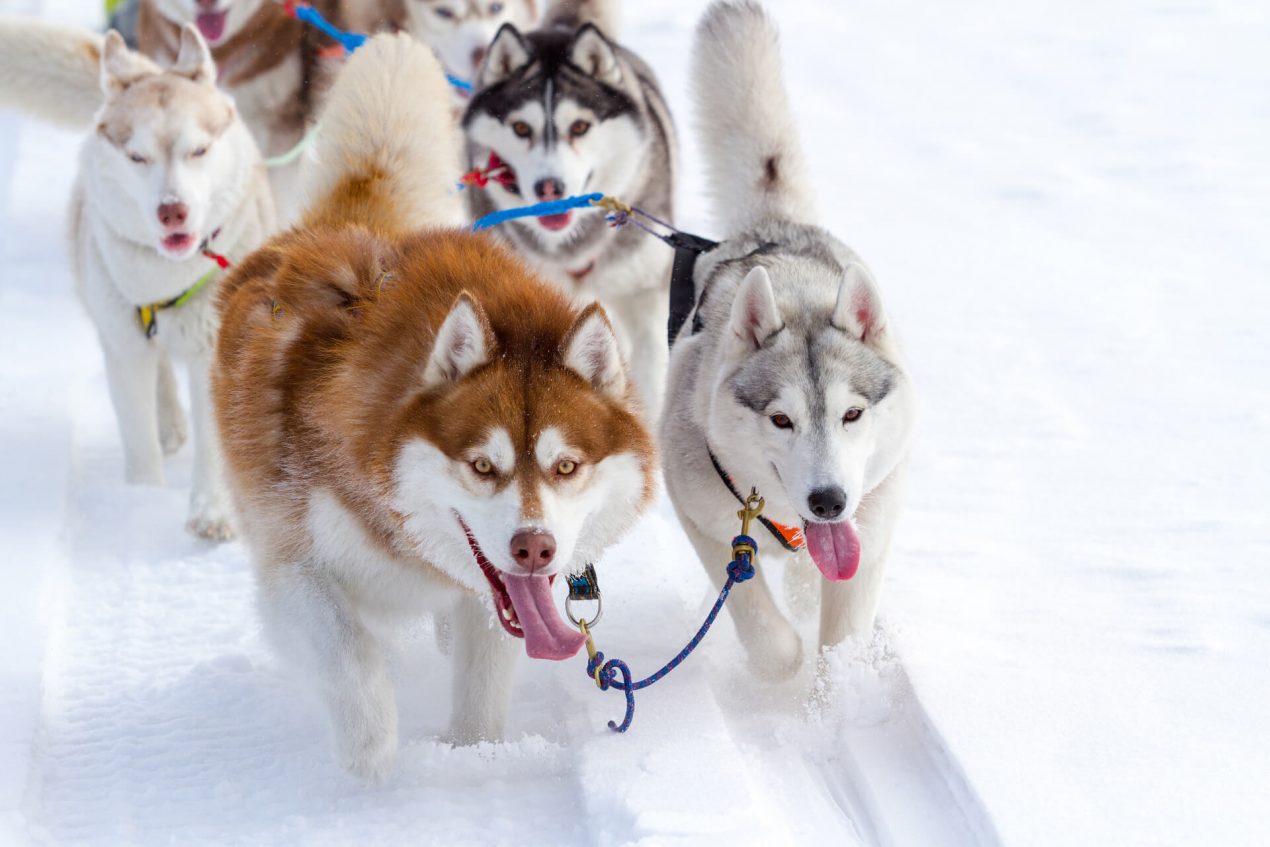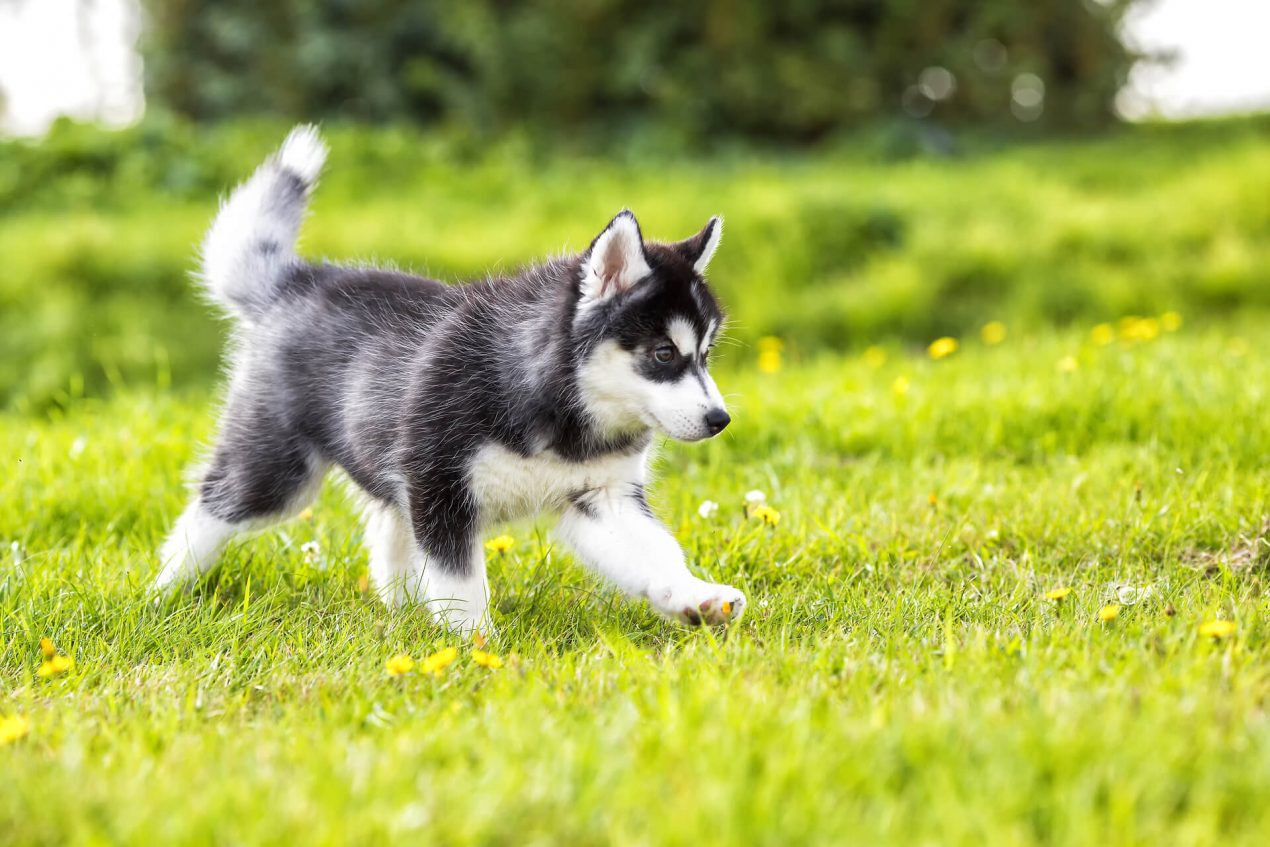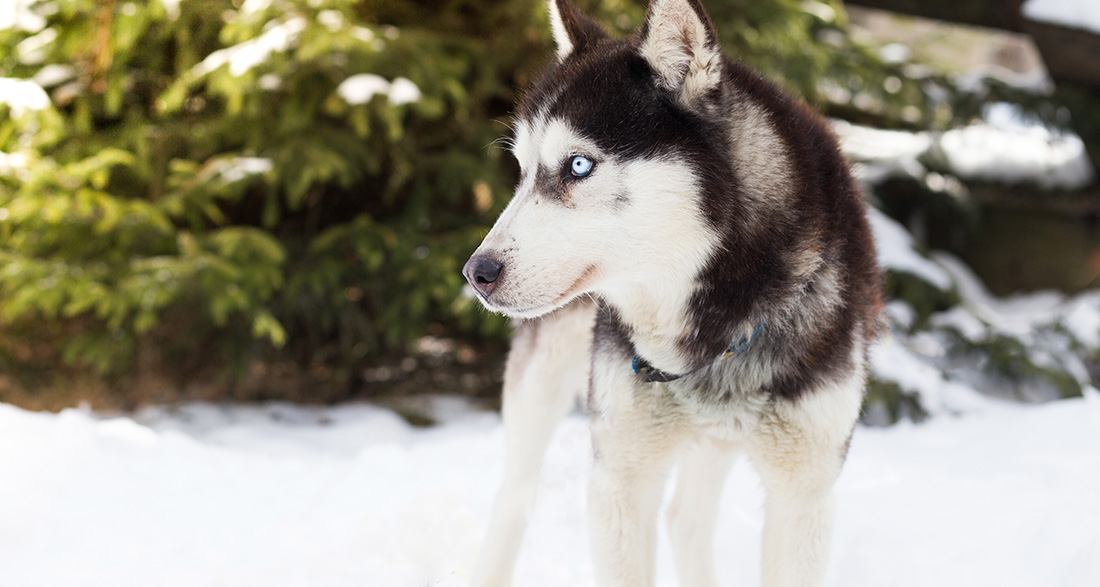The Siberian Husky is an original and rugged sled dog breed from the United States. Its appearance resembles that of a wolf. In the profile, you’ll learn everything about the history, temperament, and care of these beautiful dogs.
History of the Siberian Husky
The ancestors of the Siberian Husky originate from Siberia, where they were bred by the indigenous nomadic peoples, particularly the Chukchi in Northeast Asia, as early as the 19th century. These dogs were known for their toughness and endurance and played a crucial role as sled dogs in extremely cold climates.
- 1909: The Siberian Husky was introduced to Alaska by the Siberian fur trader William Goosak when he participated in the “All-Alaska Sweepstakes Sled Dog Race” with his dogs. Despite initial skepticism due to their small size compared to the Alaskan Malamutes, the Huskies impressed with their speed and agility, ultimately securing them third place.
- 1910: Norwegian musher Leonard Seppala began breeding Huskies outside Siberia with his male Togo, contributing to further popularizing the Husky breed.
- 1925: A significant event in the history of Siberian Huskies was their involvement in delivering life-saving serum during the diphtheria outbreak from Nenana to Nome in Alaska, demonstrating their reliability and endurance.
- 1930: The breed was officially recognized in the United States.
- 1966: The FCI (Fédération Cynologique Internationale) classified the Siberian Husky into Group 5 “Spitz and Primitive Types,” Section 1 “Nordic Sled Dogs.”
Siberian Huskies were valued not only for their sledding abilities but also for their low food requirements and ability to survive in cold temperatures. Over time, they were used for various expeditions, including Antarctic explorations and search and rescue missions during World War II.
Today, Siberian Huskies are popular worldwide as family pets, with some regions still employing them in their traditional role as sled dogs and in sports like skijoring.
Breed Overview
GROUP: Working
HEIGHT: 20 to 23.5 inches
WEIGHT: 35 to 60 pounds
COAT: A dense, double coat
COAT COLOR: Seen in a variety of colors, including combinations of black, gray, white, and tan. They have markings that include black points, piebald, or pinto
LIFE SPAN: 12 to 15 years
TEMPERAMENT: Intelligent, alert, friendly, protective, gentle
HYPOALLERGENIC: No
ORIGIN: Siberia
Character and Personality of the Husky
The Siberian Husky is a dog breed known for its sociability, athleticism, and original nature. These dogs are not only friendly and gentle but also people-oriented, forming strong bonds with their owners. They are considered excellent family dogs, getting along well with children and other dogs while developing a close relationship with their caretakers. Despite their independence and sometimes stubborn and willful Husky personality, with proper socialization and training, they can become integral parts of family life.
- Sociability: Huskies enjoy the company of their family and get along well with other dogs. They should not be left alone as they prefer companionship.
- Friendliness: They are open and friendly towards humans and other animals, making them ideal companions.
- Independence: Known for their independence, Huskies can sometimes be stubborn, presenting a challenge in training.
- Protectiveness: Although friendly to strangers, they would protect their family from threats.
Behavior and Integration:
- Prey Drive: Many Huskies have a strong prey drive, so it’s essential to focus on recall in training.
- Integration into households: Huskies integrate well into various household types, especially active families who can invest time and energy into their training and enrichment.
- Behavior towards children and pets: They generally get along well with children and other dogs, but caution is advised with small animals due to their prey drive.
- Training: Their independence and sometimes stubborn behavior can make training challenging, but with patience and consistency, they can be well-behaved.
Special Considerations:
- Not for Beginners: Due to their high demands and independence, Huskies are not necessarily suitable for beginners.
- Athleticism: As highly athletic dogs, Huskies are particularly suited for active owners. They excel as sled dogs and require regular exercise.
The Siberian Husky is a lovable and versatile breed that fits well into a loving and active home. Their ability to form strong bonds, combined with their friendly and protective nature, makes them valuable family members.
| Affection Level | High |
| Friendliness | High |
| Kid-Friendly | High |
| Pet-Friendly | High |
| Exercise Needs | High |
| Playfulness | High |
| Energy Level | High |
| Trainability | Medium |
| Intelligence | Medium |
| Tendency to Bark | High |
| Amount of Shedding | Medium |
Appearance of the Siberian Husky
The Siberian Husky is characterized by its wolf-like appearance, with a shoulder height of 50 to 60 centimeters and a weight of approximately 15.5 to 28 kilograms. This breed is known for its variety of coat colors and textures as well as its striking eyes.
Body Structure and Coat:
- Coat Texture: Possesses very dense undercoat and fur-like guard hair. Coat colors range from black to white, with the guard hair able to take on all shades. The undercoat is typically white and dense.
- Body Structure: Muscular with a slight arch in the back, a deep, laterally flattened chest, and well-arched ribs. This structure supports speed and endurance.
Limbs:
Straight, moderately boned, and muscular, with densely haired paws that are oval and medium-sized. Pads are thick, contributing to the efficiency of their movement.
Head and Face:
- Eyes: Almond-shaped, slightly slanted, and can be blue, brown, parti-colored, or heterochromatic.
- Ears: Set high, triangular, medium-sized, standing erect with semi-pointed tips.
- Muzzle and Facial Profile: Tapers gradually with a well-defined stop. Lips are tight and close, while nose pigmentation varies.
Tail and Gait:
- Tail: Bushy, carried upright and over the back in a sickle-shaped form.
- Gait: Agile and fast, smooth and ground-covering with little visible effort, underscoring their efficiency and endurance.

Puppy Training
The Siberian Husky is known for its openness and honesty when it comes to working with its humans. These independent polar dogs thrive best under the guidance of experienced dog owners. A solid education based on consistency and discipline is essential to raise the Husky to be a loyal and incomparable companion.
Basic Training:
- Positive Reinforcement: Siberian Huskies respond particularly well to praise and rewards.
- Early Socialization: It is important to introduce them early to various people, places, and situations.
- Clear Leadership: These dogs require clear and consistent instructions to direct their independence into productive channels.
Puppy School:
- Visiting a puppy school is essential for social Huskies, allowing them to make contacts with fellow dogs.
- Many breeders require attendance at a dog school as a condition for giving away their Husky puppies.
Physical and Mental Stimulation:
- Physical Needs: Due to their origins as sled dogs, Siberian Huskies have a pronounced need for physical activity.
- Activities: Long walks, jogging, pulling sports like bikejoring or canicross, as well as agility training are ideal for meeting their high energy needs.
- Strategies Against Boredom: Regular, challenging exercises are important to prevent boredom and resulting undesirable behavior.
Activities with the Siberian Husky
The Siberian Husky is an active dog who wants to run extensively every day. As an original sled dog, even the show-line Huskies are still enthusiastic draft animals. There are many ways to engage the dogs without snow. For example, there is the sport of canicross, where the dog pulls a kind of sled on wheels using a waist belt. In bikejoring, they pull a mountain bike. In scooterjoring, a special scooter, and in skijoring, a skier. You can of course take the Husky with you for hiking, cycling, or jogging. It is important that he does not get bored. For the intelligent breed, it is also relevant to be mentally challenged.

Care of a Siberian Husky
The Siberian Husky is known for its low-maintenance coat, which requires minimal grooming effort. However, there are special care guidelines that you should follow to keep your Husky healthy and happy.
Coat Care:
- General: For most of the time, lightly brushing the Husky’s coat is sufficient. This keeps the coat clean and prevents matting.
- During shedding: During this time, Huskies shed their undercoat in clumps. They rely on your increased assistance during this period. Regular brushing helps remove loose fur and prevent skin issues.
- Use specialized undercoat brushes or combs to effectively remove the undercoat during shedding. This keeps the Husky’s coat in good condition and minimizes hair distribution in the house.
Nutrition:
- Balanced diet: A healthy diet supports the vitality of the Husky. Make sure the food is balanced and contains all necessary nutrients in the form of vitamins and minerals, which are especially important under stress.
- Tailored to activity level: Consider the high energy needs of the Siberian Husky. They require a diet that matches their activity level to promote their energy and health.
- Look for high-quality dog food specifically tailored to the needs of athletic breeds like the Siberian Husky. Food with high meat content and low fillers helps meet energy needs and support muscle health.
Avoid overheating: Special caution is required in summer, as Huskies can be prone to overheating due to their thick undercoat. Provide ample shade and fresh water to prevent overheating.
Health and Genetic Diseases
Siberian Huskies are generally very robust dogs, rarely having breed-specific diseases. You can support their health by giving them a balanced and healthy diet.
Common health problems:
- Benign familial hyperphosphatasemia: A harmless disease that occurs in Huskies from the 11th week of life. It means that a certain value in the blood (alkaline phosphatase) is higher than normal, but it doesn’t bother the dogs, and they show no signs of illness.
- Juvenile cataracts: An eye disease that can affect Huskies between nine months and two years of age. About 6.6% of Huskies can get this cloudiness of the lens in the eye. There are tests to detect the risk.
- Corneal dystrophy: An eye disease that causes cloudy spots on the eyes. It usually appears between six months and two years.
- Patellar luxation: A condition where the kneecap does not sit properly. It can lead to limping, and sometimes surgery is necessary.
- Hip dysplasia: A disease that affects the hip joints and can cause pain and arthritis.
Other health concerns:
- Hypothyroidism: A thyroid disease that 11.7% of Huskies can be affected by.
- Cryptorchidism: A condition where one or both testicles do not descend into the scrotum.
- Other diseases such as epilepsy, skin problems, certain eye diseases, and others have also been found in Huskies.
Prevention and Care:
- Early socialization and regular check-ups with the veterinarian can help prevent or detect many of these problems early.
- Healthy food and enough exercise are important to keep your Husky fit and healthy.
By taking care of your Husky’s health and watching for signs of illness, you can ensure that your dog leads a long and happy life.

Does the Siberian Husky Suit Me?
The striking appearance, original nature, and elegant demeanor of Huskies attract many fans. If you’re considering getting a Siberian Husky as a pet, you don’t need to be a trained musher. However, you should have some experience with dogs and enough time to dedicate to your four-legged friend. Before making a decision, it’s essential to attend a sled dog race and observe the dogs in action. Huskies love winter and cold weather, so you should be prepared for long walks in the snow. Ideally, you should keep them in a house with a large, secure garden where they can play and roam freely.
When purchasing a puppy, make sure the breeder is affiliated with the Siberian Husky Club of America. Plan to spend between $1500 and $2000 for a purebred puppy with papers. If you’re considering adopting an adult dog, you can often find representatives of the breed or mixes in animal shelters. While they may be older, they are usually grateful dogs who appreciate any kind of affection.
Interesting and Worth Knowing
With sufficient training, the Siberian Husky is capable of pulling nine times its own body weight. Therefore, in 20th-century Alaska, these dogs were vital working animals. When a diphtheria epidemic broke out in the remote town of Nome during the polar winter of 1925, no help could reach them through the deep snow. So, the government sent some brave mushers with their Husky sleds to transport the life-saving serum over 1000 kilometers.
Among those involved were Leonhard Seppala and his lead dog Togo, as well as Gunnar Kaasen and Balto. Since Kaasen completed the final leg to Nome, he received most of the fame. His lead dog, Balto, even received a statue in Central Park. Balto remained at the Cleveland Zoo until his death and was later stuffed and displayed at the Cleveland Museum of Natural History. The story of the dog inspired the 1995 animated film “Balto,” which portrayed him as a hero.
Do you have a Siberian Husky or are you thinking of getting one? Share with us in the comments what you think makes them so special!


